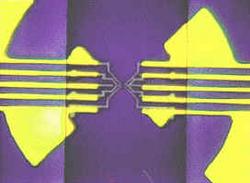Signals from an Artificial Molecule

Physicists can now probe a puddle of 100 or fewer electrons isolated in a small slab of semiconducting material. They have even detected individual electrons coming and going from these “quantum dots.” Now a team reports in the 20 July PRL that they can detect a single electron hopping back and forth between two adjacent dots and potentially follow its motion in detail. Similar experiments may allow new detailed studies of single electrons in these structures and bring physicists a step closer to developing computers based on them.
One popular type of quantum dot is made with a thin sandwich of semiconducting material that confines electrons to a plane. Then microscopic metal electrodes are added in a sort of “corral” shape that allows an electric field to herd a group of electrons into a small area of the material. Researchers hope to build a computer that uses the states of quantum dot electrons to represent the ones and zeroes of the binary code, permitting a dramatic miniaturization over today’s microchips. But first they must learn more about the basic principles of small groups of electrons.
Quantum dots are sometimes called “artificial atoms” because the confined electrons act like those of a single atom, giving rise to a set of atomlike energy levels, for example. A pair of interacting quantum dots could be called an “artificial molecule.” Robert Blick, of the Ludwig Maximilians University in Munich, and his colleagues wanted to study the responses of such a pair to microwave radiation–the low energy photons that can stimulate transitions in real molecules.
The team used a new type of microwave system that allows extremely precise control of the frequency as well as the ability to produce a wide range of frequencies (7 to 400 GHz ) at one time. While hitting the dot pair with this “broadband” radiation, they measured the electric current oscillating between the dots at each frequency and found enhanced current at several frequencies. This type of spectrum was only possible because of their advanced microwave system, which also allowed them to track the phase of the oscillating current–its advance or delay compared to the incident microwave oscillations–at three of the resonance frequencies. One of these resonances corresponded to the expected frequency for a single electron to oscillate between the two dots, and at that frequency the team found a complicated phase behavior that they say signals the electron’s back-and-forth motion.
Raymond Ashoori of MIT says the technique is potentially important because it allows a direct measurement of the phase of a single electron–the key to completely characterizing its quantum state. If researchers are ever to develop a quantum dot computer, they must measure and control quantum states as precisely as possible. On the other hand, he adds that the phase data in this paper are somewhat difficult to interpret, and the system may need further development.


